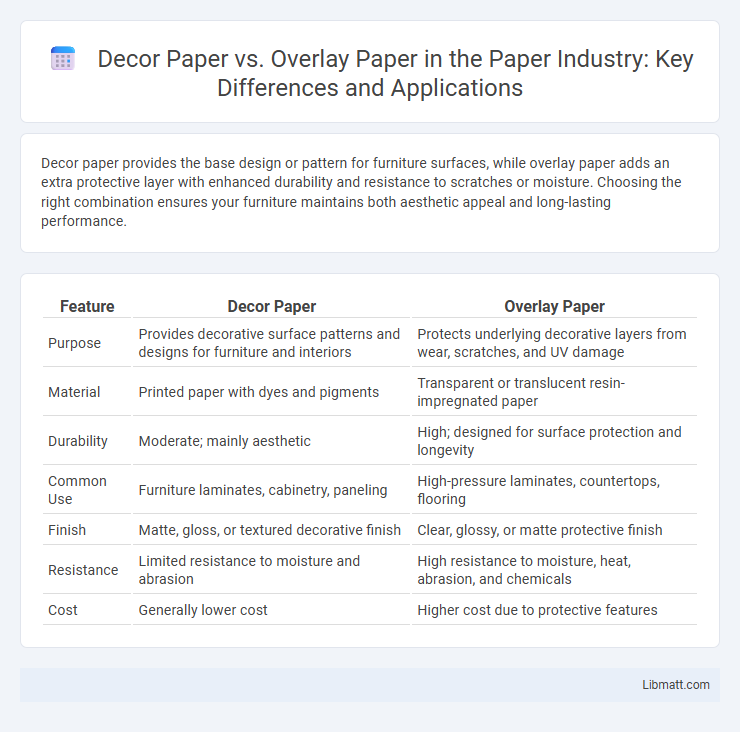Decor paper provides the base design or pattern for furniture surfaces, while overlay paper adds an extra protective layer with enhanced durability and resistance to scratches or moisture. Choosing the right combination ensures your furniture maintains both aesthetic appeal and long-lasting performance.
Table of Comparison
| Feature | Decor Paper | Overlay Paper |
|---|---|---|
| Purpose | Provides decorative surface patterns and designs for furniture and interiors | Protects underlying decorative layers from wear, scratches, and UV damage |
| Material | Printed paper with dyes and pigments | Transparent or translucent resin-impregnated paper |
| Durability | Moderate; mainly aesthetic | High; designed for surface protection and longevity |
| Common Use | Furniture laminates, cabinetry, paneling | High-pressure laminates, countertops, flooring |
| Finish | Matte, gloss, or textured decorative finish | Clear, glossy, or matte protective finish |
| Resistance | Limited resistance to moisture and abrasion | High resistance to moisture, heat, abrasion, and chemicals |
| Cost | Generally lower cost | Higher cost due to protective features |
Introduction to Decor Paper and Overlay Paper
Decor paper features printed designs or patterns used to enhance the aesthetic appeal of furniture and cabinetry surfaces, providing a decorative layer that mimics wood grains, textures, or other visual effects. Overlay paper serves as a transparent, protective sheet applied over decor paper to shield it from scratches, moisture, and wear, thereby extending the durability and maintaining the visual quality of the underlying design. Both materials are essential components in laminate manufacturing, combining visual appeal with functional protection in interior design applications.
Key Differences Between Decor Paper and Overlay Paper
Decor paper features printed designs that create the visual appearance of wood grains, patterns, or textures used in furniture and interior surfaces, while overlay paper is a transparent, protective layer that enhances durability and resistance to wear. Decor paper primarily contributes to aesthetic appeal, whereas overlay paper functions as a protective barrier against scratches, stains, and UV damage. The manufacturing process also differs, with decor paper printed before lamination and overlay paper applied as a decorative or protective surface finish.
Composition and Manufacturing Process
Decor paper is typically made from cellulose fibers impregnated with melamine resin, providing durability and resistance to wear when applied to surfaces. Overlay paper consists of a clear, transparent top layer made from cellulose fibers saturated with melamine resin, offering a protective and glossy finish. Both papers undergo a high-pressure lamination process where heat and pressure cure the resin, bonding the paper to substrates like particleboard or MDF for furniture and flooring applications.
Common Applications in Interior Design
Decor paper is commonly used for furniture laminates, cabinetry, and wall paneling to provide aesthetic finishes that mimic wood grains or patterns, enhancing interior decor with durability and style. Overlay paper, typically serving as a protective and clear top layer for surfaces, is applied in laminate flooring, countertops, and heavy-use furniture to safeguard the design beneath from wear, scratches, and moisture. Your choice between decor and overlay paper hinges on whether you prioritize decorative appearance or surface protection in your interior design projects.
Physical and Mechanical Properties
Decor paper features a dense, high-quality cellulose base providing excellent printability and a smooth surface for intricate designs, while overlay paper is thinner with superior transparency and abrasion resistance to protect the decor layer. Mechanically, decor paper offers good flexibility and toughness for lamination processes, whereas overlay paper enhances durability by resisting scratches, chemicals, and heat, extending the lifespan of your finished surfaces. Choosing between them depends on your project's need for aesthetic detail or surface protection.
Advantages of Decor Paper
Decor paper offers exceptional customization options for furniture and interior design by providing a wide range of colors, patterns, and textures that mimic natural materials such as wood and stone. This type of paper enhances durability, as it is often impregnated with resins making surfaces more resistant to scratches, stains, and moisture. You benefit from cost-effective aesthetics that combine style and protection, ideal for creating visually appealing surfaces with long-lasting performance.
Benefits of Overlay Paper
Overlay paper provides superior protection to decorative surfaces by enhancing durability and resistance to scratches, stains, and wear, significantly extending the lifespan of your furniture or laminated products. Its transparent quality preserves the appearance of the underlying decor paper while adding a smooth, high-quality finish that enhances visual appeal. Using overlay paper ensures your surfaces maintain their aesthetic value and structural integrity in high-traffic or everyday use environments.
Cost Comparison and Budget Considerations
Decor paper generally costs less than overlay paper, making it a budget-friendly option for large surface coverage in furniture and cabinetry. Overlay paper, despite its higher price, offers superior durability and impact resistance, which can reduce long-term maintenance expenses. Evaluating your project's requirements and lifespan expectations helps you decide which paper aligns best with your budget and quality needs.
Choosing the Right Paper for Your Project
Choosing between decor paper and overlay paper depends on the desired finish and durability requirements of your project. Decor paper, rich in printed designs and patterns, is ideal for aesthetic surfaces such as furniture and cabinetry, providing vibrant, detailed visuals. Overlay paper offers a protective, transparent layer that enhances resistance to wear and moisture, making it suitable for high-traffic areas or applications requiring added durability.
Future Trends in Surface Finishing Papers
Future trends in surface finishing papers emphasize sustainability, with decor paper increasingly produced from recycled fibers and eco-friendly inks to meet growing environmental standards. Overlay paper manufacturers are advancing innovations in wear resistance and UV stability to enhance durability in high-traffic applications. By choosing the right paper for your project, you ensure longevity and aesthetics align with evolving industry demands and consumer preferences.
Decor paper vs overlay paper Infographic

 libmatt.com
libmatt.com